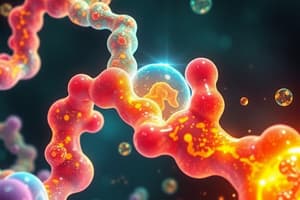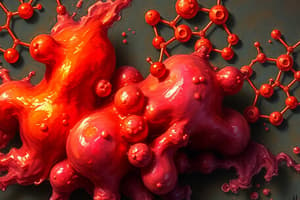Podcast
Questions and Answers
What is the measure of enzyme activity expressed as?
What is the measure of enzyme activity expressed as?
- Catalytic efficiency (CE)
- Molarity (M)
- International unit (IU) (correct)
- Mole per liter
Which type of enzyme is responsible for the transfer of electrons or hydrogen atoms?
Which type of enzyme is responsible for the transfer of electrons or hydrogen atoms?
- Isomerases
- Ligases
- Hydrolases
- Oxidoreductases (correct)
Which of the following enzymes catalyzes hydrolysis reactions by adding water?
Which of the following enzymes catalyzes hydrolysis reactions by adding water?
- Transferases
- Hydrolases (correct)
- Isomerases
- Lyases
What type of reaction do ligases primarily catalyze?
What type of reaction do ligases primarily catalyze?
Which enzyme type is characterized by converting a molecule into its isomeric form?
Which enzyme type is characterized by converting a molecule into its isomeric form?
What is the primary role of translocases in a cell?
What is the primary role of translocases in a cell?
Which of the following statements correctly describes coenzymes?
Which of the following statements correctly describes coenzymes?
What is a common function of cofactors in enzymatic reactions?
What is a common function of cofactors in enzymatic reactions?
What differentiates trypsin from catalase in terms of substrate specificity?
What differentiates trypsin from catalase in terms of substrate specificity?
What role does the active site of an enzyme play?
What role does the active site of an enzyme play?
How does an enzyme affect the activation energy of a chemical reaction?
How does an enzyme affect the activation energy of a chemical reaction?
Which of the following is a consequence of vitamin B6 deficiency?
Which of the following is a consequence of vitamin B6 deficiency?
What is meant by ΔGB in the context of enzymatic reactions?
What is meant by ΔGB in the context of enzymatic reactions?
What occurs when substrate concentration, [S], approaches infinity in Michaelis-Menten kinetics?
What occurs when substrate concentration, [S], approaches infinity in Michaelis-Menten kinetics?
In the context of Michaelis-Menten kinetics, what does Km represent?
In the context of Michaelis-Menten kinetics, what does Km represent?
How does competitive inhibition affect the Km of an enzyme?
How does competitive inhibition affect the Km of an enzyme?
What is the main characteristic of a noncompetitive inhibitor?
What is the main characteristic of a noncompetitive inhibitor?
What does Kcat represent in enzyme kinetics?
What does Kcat represent in enzyme kinetics?
In allosteric regulation, what is a modulator?
In allosteric regulation, what is a modulator?
Which statement best describes irreversible inhibitors?
Which statement best describes irreversible inhibitors?
What happens to the enzymes in acute pancreatitis?
What happens to the enzymes in acute pancreatitis?
How do kinases and phosphatases regulate enzymatic activity?
How do kinases and phosphatases regulate enzymatic activity?
What is a characteristic of allosteric enzymes?
What is a characteristic of allosteric enzymes?
Flashcards are hidden until you start studying
Study Notes
Enzyme Activity Measurement
- Enzyme activity is measured in international units (IU): 1 IU catalyzes 1 µmol of substrate to product per minute.
- Specific activity is defined as IU per milligram of protein.
Enzyme Classification
- Enzymes are classified into seven broad categories:
- Oxidoreductases catalyze oxidation-reduction reactions by transferring electrons (or hydrogen atoms).
- Transferases catalyze group transfer reactions (except hydrogen atoms).
- Hydrolases catalyze hydrolysis reactions with the addition of water.
- Lyases/Synthases catalyze bond cleavage through elimination, resulting in double bonds or ring structures, or addition of groups to double bonds.
- Isomerases catalyze isomerization reactions by transferring groups within molecules to yield isomeric forms.
- Ligases catalyze bond formation through condensation reactions coupled to ATP cleavage.
- Translocases assist in moving molecules, usually across cell membranes.
Reaction and Substrate Specificity
- Most enzymes are highly specific for the type of reaction catalyzed and the nature of the substrate.
- Examples include catalase for hydrogen peroxide and urease for urea.
- Some enzymes have broader substrate specificity, such as trypsin in protein digestion.
Active Site
- The active site is a cleft or groove where catalysis occurs.
- It contains amino acid residues that directly participate in bond making and breaking.
- The active site binds to the substrate, often with the help of cofactors or coenzymes.
Coenzymes in Enzymatic Reactions
- Cofactors are inorganic elements like calcium, iron, or copper.
- Coenzymes are organic molecules like coenzyme A.
- Coenzymes often undergo modifications during enzymatic reactions and are recycled by other enzymes.
- Coenzymes act as transient carriers of functional groups and can transport intermediates during sequences of reactions.
- Many vitamins serve as precursors of coenzymes.
- Cofactors and coenzymes can bind loosely and transiently or tightly and permanently as prosthetic groups (e.g., heme group).
Vitamin B6 and Coenzyme Derivatives
- Pyridoxal phosphate, a form of vitamin B6, is essential for amino acid synthesis, catabolism, and interconversion.
- It acts as a transient carrier of amino groups during amino acid metabolism.
- Vitamin B6 requirement increases with protein intake.
- Supplements in infant formula promote effective protein synthesis.
- B6 deficiency can lead to neurological symptoms and anemia.
Mechanism of Enzyme Action
- The enzyme's active site binds to the substrate, facilitating catalysis.
- Enzymes lower the activation energy required for the transition state.
- Enzymes increase the reaction rate without affecting the equilibrium position of the reaction.
- The binding energy released from the formation of weak interactions between the enzyme and substrate (ES complex) is denoted as ΔGB.
Enzyme Kinetics: Michaelis-Menten Kinetics
- The initial rate (V0) of an enzymatic reaction is described by the Michaelis-Menten equation:
- V0 = Vmax * [S] / (Km + [S])
- Vmax represents the maximum reaction rate when the enzyme is saturated with substrate ([ES] = [Etotal]).
- Km is the substrate concentration at which the initial rate is half of its maximal rate.
- Km reflects the dissociation constant for the ES complex (E + S) and indicates the enzyme's affinity for its substrate.
- A lower Km indicates a higher affinity for the substrate and vice versa.
- The equation is derived from the initial rate of a simple enzymatic reaction, assuming that the rate of the first step (E+S → ES) is much slower than the rate of the second step (ES → E + P).
Lineweaver-Burk Double Reciprocal Plot
- Taking the reciprocal of both sides of the Michaelis-Menten equation yields the Lineweaver-Burk equation:
- 1/V0 = Km/(Vmax*[S]) + 1/Vmax
- This equation represents a linear equation (y = mx + c).
- The slope of the Lineweaver-Burk plot is Km/Vmax, and the y-intercept is 1/Vmax.
Turnover Number (Kcat)
- Kcat represents the number of substrate molecules converted to product per unit time when the enzyme is saturated with substrate.
- Kcat is determined by the rate constant of the step ES → E + P, represented by k2.
- If ES → E + P is the rate-limiting step, then k2 = Kcat.
- The unit of Kcat is s-1.
Catalytic Efficiency (Kcat/Km)
- Kcat/Km reflects the catalytic efficiency of an enzyme, combining both the rate of catalysis (Kcat) and the affinity for the substrate (Km).
Nature and Inhibition of Enzymes
- Competitive Inhibition (reversible):
- The inhibitor competes with the substrate for the active site.
- The effect can be overcome by increasing substrate concentration.
- The inhibitor does not inactivate the enzyme.
- Vmax remains unchanged.
- Km increases (decreased substrate affinity).
- The Lineweaver-Burk plot shows an increased slope.
- Noncompetitive Inhibition (reversible):
- The inhibitor binds to a site distinct from the active site, affecting both E and ES complex.
- The inhibitor can inactivate the enzyme.
- Vmax decreases.
- Km remains unchanged.
- The Lineweaver-Burk plot shows an increased slope and a higher y-intercept.
- Irreversible Inhibition:
- The inhibitor binds strongly to the active site, often through covalent bond formation.
- Suicide inactivators are irreversible inhibitors that initially perform the first few steps of the reaction but cannot be converted to product, leading to permanent enzyme inactivation.
Regulation of Enzymatic Reactions
- Allosteric Regulation:
- Allosteric enzymes are typically larger and have at least two subunits (catalytic and regulatory).
- They interact with inhibitors and activators, which are usually small metabolites or cofactors.
- The binding of the modulator (inhibitor or activator) causes conformational changes in the enzyme.
- These changes can affect catalytic activity.
- Aspartate transcarbamoylase is an example of an allosteric enzyme, regulated by CTP (inhibitor) and ATP (activator).
- Reversible Covalent Modification:
- This involves the addition or removal of phosphoryl groups, affecting the structure and catalytic activity of enzymes.
- Kinases add phosphate groups, while phosphatases remove them.
- Proteolytic Cleavage of Enzyme Precursor:
- Digestive enzymes are often synthesized and stored as inactive precursors called zymogens or proenzymes.
- Proteolytic cleavage activates these precursor enzymes.
Acute Pancreatitis
- This condition arises when pancreatic enzymes become activated within the pancreatic ductal system.
- The activated enzymes damage proteins on the cell surface and blood vessels.
- Serum contains natural inhibitors for trypsin (antitrypsin).
- Normally, pancreatic enzymes remain inactive until reaching the duodenum.
Enzymes in Health and Disease
- Numerous enzymes are involved in various important physiological processes (e.g., digestion, metabolism, and energy production).
- Enzyme deficiencies or malfunctions can lead to diseases.
- For example, deficiencies in lysosomal enzymes can cause genetic disorders.
- Enzyme inhibitors are widely used as therapeutic agents.
Studying That Suits You
Use AI to generate personalized quizzes and flashcards to suit your learning preferences.




